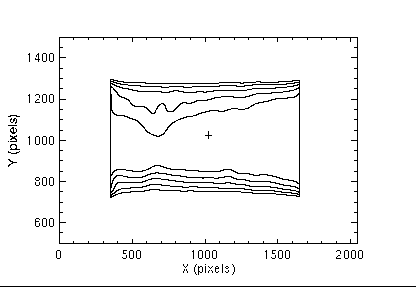
Like any astronomical instrument, the sensitivity of the EUVE deep survey telescope varies across the field of view. When mapping faint diffuse emission, this variation and the corresponding variation in the photon background must be compensated for.

The above figure is a smoothed contour plot of long duration background images of blank fields taken with the EUVE deep survey telescope. Each contour represents a 10% change in the instrument background. This background consists of two components, a non-photonic "dark rate" component, B_int, due to charged particles and radioactive decay within the detector, and a photonic background, B_vig due to atmospheric glow and emission from the interstellar medium. Because the deep survey telescope is not a shuttered instrument, it is not possible to directly measure the "dark rate." Because of its nature, this non-photonic background should be fairly constant over the surface of the detector. Thus we expect that any variations in the background are due to processes that only affect the measurement of photons, such as vignetting and variations in efficiency over the surface of the detector.
In practice, either of these backgrounds can vary from image to image. Because the ratio of these two backgrounds can vary, we must correct for this effect when scaling previously measured backgrounds to the backgrounds of our observations. To determine B_int for an observation, we measure the count rate in highly obscured regions of the detector. B_vig is determined from our long duration background image (with its own internal background, determined as above, subtracted). Therefore our background subtracted count rate image is:
We provide here our raw background image, and the image mask we have used in the determination of B_int.